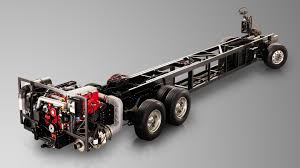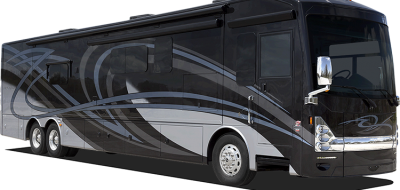
Diesel pusher chassis
Diesel pusher motorhomes are hardy vehicles, but they’re not indestructible. Here’s a list of seven potentially damaging diesel pusher mistakes that owners should avoid.
• Fueling from both sides at the same time. Most diesel pushers (DPs) have fuel ports on both sides. Truck fuel stations generally have a master pump on one side with a slave pump on the other. This accommodates the filling of separate saddle tanks located on each side. They are not for filling a single tank of a dual ported vehicle. Doing so will lead to a serious fuel spill while pumping.
• Applying hard application of the service brakes while the park brake is engaged. High air pressure combined with the powerful spring brakes located in the tandem air chambers on the drive axle can damage the mechanical rods and linkages that control the brake action. Fortunately, all modern air brake vehicles have an anti-compounding valve designed specifically for this issue. It reduces air pressures being applied during such events. Regardless of this feature, it is common practice to tread lightly as not to rely solely on such safety devices.
• Pumping or dragging the service brakes while slowing or checking speed. Pumping the air brakes can cause the exhaustion of volume of compressed air in excess of what the compressor can produce. Dragging the brakes can cause rapid overheating of the brake system. These actions can reduce the efficiency of the braking system and possibly lead to total failure. Air brakes should be applied briskly as needed and released.
• Moving the vehicle prior to it fully airing up. Most DP’s must be at their highway ride height in order to have adequate wheel clearance between the front tires and the fenders. Additionally, driveline universal joints can be stressed by the acute angle that exists when the air suspension is fully down.
• Shutting down a hot engine or while above idle speed. Diesel engines must be allowed to cool down briefly prior to shutdown. This is primarily needed for a turbocharged engine. It requires only about 3 minutes and in many cases has nearly elapsed while pulling off the road. Also only shutdown while on low idle to avoid possible turbo damage.
• Checking the fluid level of an Allison transmission using the dipstick of an electronic fluid level equipped set-up. For units with this feature, the manufacturer recommends the use of the electronic method as it is far more accurate. The depressing of the up-and-down arrows simultaneously on the shift pad displays this feature if so enabled.
• Storing a DP with a tank full of 20 percent bio-diesel blend (B-20) fuel for a duration of over 90 days. Engine maker Cummins recommends not storing vehicles with high bio-diesel blends (B-20) for over 90 days as fuel system component issues may occur.
Well, that’s some of the DP owner’s “no-nos.”
Peter Mercer – Being Good To Your Diesel Pusher







Dennis
I have a 2001 Freightliner Fleetwood discovery motorhome with a Cat 3126 and I am having a starting problem. Is there a fuel pump in the fuel tank?